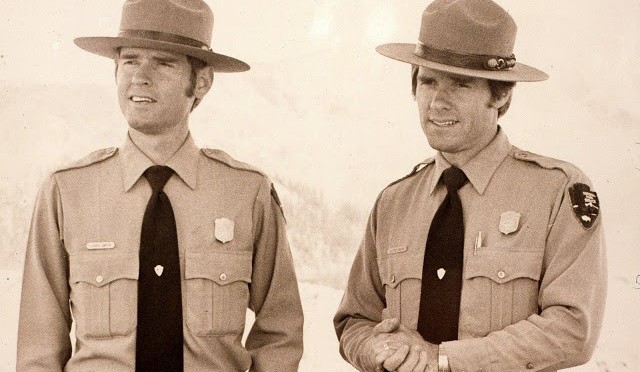Footnotes:
- The Crater Wall Trail, which started at Rim Village and went to the south shore of Crater Lake.
- Concessionaires from 1954 to 1958.
- Hallock was Chief Ranger at Crater Lake from 1949 t o1953.
- Robert Benton was superintendent from 1984 to 1991.
- Equipment operator from 1958 to 1991.
- Ruth Hopson Keen, who worked the summer seasons of 1947- 1949.
- Annual leave.
- Retirement calculations are based on the highest three years of salary.
- Otto Brown retired as Superintendent from Crater Lake, serving from 1954 to 1961. Thomas J. Williams, Superintendent from 1954 to 1959, later became Regional Director in Sante Fe.
- Ward Yeager retired from Crater Lake, having served as Superintendent from 1961 to 1964.
- Building 14, originally constructed in 1954, expanded with an addition [14A] in 1964, reconfigured and expanded again in 1991.
- Formerly Chief Ranger of Glacier National Park. Sent to Crater Lake later in his career to be Superintendent. He served from 1964 to 1965.
- Johnson served as Superintendent from 1970 to 1973.
- Built by CCC enrollees at Oregon Caves in 1937.
- Presently the office of the Crater Lake National History Association. (this was the original office- left of entry)- Later moved to an opening- left of fire place.)
- An elementary school for the children of park employees was held in the Administration Building from 1949 to 1963, and then moved to what is now known as the Community Center where it was phased out in 1966.
- Resident landscape architect at Crater Lake, 1934 to 1939.
- This feature appears to have been tied to Dave Canfield, superintendent from 1934 to 1937. The adaptive rehabilitation of the Administration Building took place in 1986-87.
- Superintendent from 1973-1975.
- This took place in August 1988. A team from the regional office, headed by then deputy regional director William J. Briggle, did the evaluation.
- Superintendent from 1978 to 1983.
- Jim Wiggins.
- The park was closed for three weeks in August 1975 because of the water crisis.
- Superintendent from 1976 to 1978.
- Chief Ranger from 1976 to 1981.
- House 28. Hank is Tanski, who served at the Supervisory Ranger [Interpretation] from 1978 to 1988.
- The interviewer was hired while Benton served as superintendent, in 1988.
- Superintendent from 1902 to 1913.
- Building 222 was built as a school in 1963.
- Juillerat is a reporter for the Klamath Falls Herald and News who has covered the park since 1972.
- The Parkscape symbol. Hartzog was NPS Director from 1964 to 1972.
- A logo endorsed by the Department of the Interior in 1973.
- Character used to promote tidiness in public lands beginning in 1970.
- Subject of a popular comic strip in Sunday newspaper.
- See not 31. The Parkscape Symbol was supposed to better incorporate recreation into the NPS persona then had the Arrowhead symbol.
- Departmental logo of the late 1960’s and early 1970’s. Sometimes called “the good hands” emblem.
- The campground site served as Park Headquarters from 1903 to 1922.
- The old roadbed, abandoned when Highway 62 and the junction were realigned in 1962. Part of it has been used as RV space for concessions employees since 1993.
- Opened in 1936 and abandoned by 1970.
- Known previously as he Watchman Overlook.
- Actually the second. Building 227, next door to it, was begun in 1957.
- Begun in 1958 and completed in 1961.
- Buildings 15, 18, 26, 219, 221, and 226.
- The Western Office of Design and Construction.
- The Arab Oil Embargo of 1974.
- Sloped roofs were added, along with an extra garage, in 1991 and 1992.
- Newton Drury served as NPS Director from 1940 to 1951, and then headed the California State Parks from 1952 to 1959.
- The reference is to the entrance signs placed at the north, west, and south entrances in 1970.
- Winter headquarters was in Medford from 1917 to 1965.
- The Klamath Falls Group Office was in existence from 1969 to 1982.
- This extension was proposed from 1926 or so to roughly 1940.
- Proposed from 1941 to 1968. It surfaced again in 1993.
- About a mile south of Wilson’s on Highway 62. Presently known as the Crater Lake RV Park.
- This occurred because John Davis left the group. There was on chief interpreter in the park from 1969, when Bob Bruce transferred, to 1977, when Pat Smith was hired. During that period, supervisory rangers Pawl Crawford and then George Morrison oversaw operations with an I&RM framework.
- Line authority was vested in the Park Superintendent, not Group Office personnel.
- The Ranger Technician Series [026], now abolished.
- Miele served as Superintendent at Oregon Caves from 1974 to 1985. He then transferred to Crater Lake.
- The park has been part of the Western Region except for the period 1969-1974, when it joined the Klamath Falls Group and became part of the Pacific Northwest Region.
- Managed by the Superintendent at Crater Lake from 1934 to 1975, and since 1985.
- Ralph Peyton and the Crater Lake Lodge Company sold to Canteen Corporation of Oregon [later Estey Corporation] in 1976. The Oregon Cave Company sold to Canteen in 1977.
- The albums are held by the Oregon Historical Society.
- Maben was the winter caretaker of Crater Lake Lodge from 1924 to 1928.
- Crater Lake: The Story Behind the Scenery, Las Vegas: KC Publications, 1982.
- Building 66, initially constructed as a photographer’s [Kiser’s] studio in 1921.
- Pat O’Hara, the photographer for The Mountain That Used to Be.


